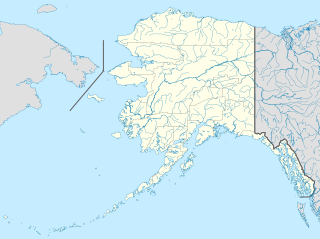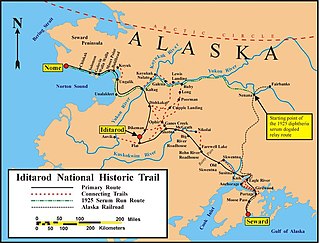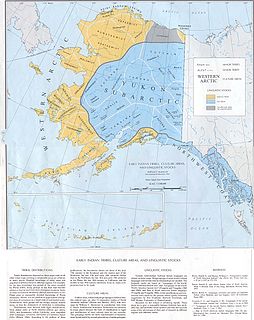| Iditarod River | |
|---|---|
| Location | |
| Country | United States |
| State | Alaska |
| Census Area | Bethel, Yukon–Koyukuk |
| Physical characteristics | |
| Source | north of the Russian Mountains |
| - location | north of Chuathbaluk on the Kuskokwim River, Bethel Census Area |
| - coordinates | 61°46′54″N158°55′44″W / 61.78167°N 158.92889°W [1] |
| - elevation | 1,103 ft (336 m) [2] |
| River mouth | Innoko River |
| - location | 25 miles (40 km) northeast of Holikachuk, Yukon–Koyukuk Census Area |
| - coordinates | 63°01′46″N158°45′57″W / 63.02944°N 158.76583°W Coordinates: 63°01′46″N158°45′57″W / 63.02944°N 158.76583°W [1] |
| - elevation | 56 ft (17 m) [1] |
| Length | 325 mi (523 km) [1] |
The Iditarod River is a 325-mile (523 km) tributary of the Innoko River in the U.S. state of Alaska. [1] The river begins north of Chuathbaluk and the Russian Mountains and flows northeast and then west to meet the larger river near Holikachuk. [3]

The Innoko River is a 500-mile (800 km) tributary of the Yukon River in the U.S. state of Alaska. It flows north from its origin south of Cloudy Mountain in the Kuskokwim Mountains and then southwest to meet the larger river across from Holy Cross.

In the United States, a state is a constituent political entity, of which there are currently 50. Bound together in a political union, each state holds governmental jurisdiction over a separate and defined geographic territory and shares its sovereignty with the federal government. Due to this shared sovereignty, Americans are citizens both of the federal republic and of the state in which they reside. State citizenship and residency are flexible, and no government approval is required to move between states, except for persons restricted by certain types of court orders. Four states use the term commonwealth rather than state in their full official names.

Alaska is a U.S. state in the northwest extremity of North America, just across the Bering Strait from Asia. The Canadian province of British Columbia and territory of Yukon border the state to the east and southeast. Its most extreme western part is Attu Island, and it has a maritime border with Russia to the west across the Bering Strait. To the north are the Chukchi and Beaufort seas—southern parts of the Arctic Ocean. The Pacific Ocean lies to the south and southwest. It is the largest U.S. state by area and the seventh largest subnational division in the world. In addition, it is the 3rd least populous and the most sparsely populated of the 50 United States; nevertheless, it is by far the most populous territory located mostly north of the 60th parallel in North America: its population—estimated at 738,432 by the United States Census Bureau in 2015— is more than quadruple the combined populations of Northern Canada and Greenland. Approximately half of Alaska's residents live within the Anchorage metropolitan area. Alaska's economy is dominated by the fishing, natural gas, and oil industries, resources which it has in abundance. Military bases and tourism are also a significant part of the economy.
Iditarod is an Anglicization of the Deg Hit’an (Athabascan) name for the river, Haiditirod or Haidilatna, [1] which is probably an English version of the name of a village on the river, that may have corresponded with the village called Iditarod in the 1900s.
The Deg Hitʼan language, Deg Xinag, also known as Ingalik, is a moribund Northern Athabaskan language spoken by the Deg Hitʼan peoples in the villages of Shageluk, Anvik, and Holy Cross along the lower Yukon River in Alaska. Out of an ethnic population of approximately 250 people, only 14 people still speak the language.

Iditarod is an abandoned town in the Yukon-Koyukuk Census Area in the U.S. state of Alaska. It is presently located within the boundaries of the Flat Census Designated Place, which has no residents as of 2010.












